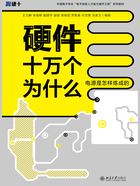
序1
PREFACE
The author team of this book provides thorough explanations of principles, analyses of applications, and offers a plethora of case studies and simulation data. This aids readers in comprehending the principles of power supply technology and its practical applications, mastering the core aspects of power supply application techniques. The book delves into various aspects such as the background knowledge of power sources, the non-idealities of power source components, and the importance of power integrity. It systematically introduces readers to the fundamental concepts and classification methods in the field of power sources, covering different classifications such as conversion types, linear/switching, isolated/non-isolated, and modulation types. This book helps readers review some fundamental concepts such as effective current, Fourier transform, and control theory, forming a complete learning cycle. It also enables theoretical understanding combined with practical application, which is very helpful for developers to solidify their foundational knowledge and apply it to real projects.
The book discusses the purposes and non-idealities of each type of component in power source circuits. It might be a good point to start learning about power sources. This is what sets this book apart from other power supply literature—its unique perspective from the viewpoint of circuit designers, making it highly practical.
The chapter about power integrity is a very good resource to learn about this topic. It first explains power integrity by listing the factors that would affect power integrity. Some factors such as the instantaneous load current and the choices of decoupling capacitors are explained in detail with examples and simulations. Furthermore, the concept of PDN and target impedance are explained briefly. After that, the book introduces the full procedures of setting up and running ADS simulations (DC, AC, and electro-thermal). Each step is explained in detailed instructions and illustrated by software screenshots. I particularly like that the book has deeper explanation of some of the options in simulation settings. I think it is a good way to better understand the simulations. The procedures of obtaining capacitor models are explained in detail in the AC simulation part. After all the simulations, the book shows the procedures of impedance optimization.
The book explains concepts and procedures in a detailed but not complicated way. In addition, the word choice throughout the book make me feel comfortable.
Picotest CEO Steve Sandler
这本书的作者团队对电源技术的原理进行了深入的解释,分析了具体应用,并提供了大量的研究案例和仿真数据。这有助于读者理解电源技术的原理及其实际应用,以及掌握电源应用技术的核心方法。该书深入探讨了诸如电源的背景知识、电源电路中各种元器件的非理想性及电源完整性的重要性等各个方面。它系统地向读者介绍了电源领域的基本概念和分类方法,涵盖了不同的分类,如电源转换类型、线性/开关型、隔离/非隔离型和调制类型等。该书帮助读者复习了一些基本概念,如有效电流、傅里叶变换和控制理论,形成了一个完整的学习循环。它将理论理解与实际应用相结合,能帮助开发人员巩固基础知识,并将其应用于实际项目。
该书讨论了电源电路中每种类型组件的目的和非理想性。这可能是开始学习电源的一个很好的起点。这正是这本书与其他电源文献不同的地方——它以电路设计者的视角提供了独特的观点,使其具有高度的实用性。
关于电源完整性的章节是学习该主题的一个很好的资源。它首先通过列举影响电源完整性的因素来解释电源完整性。例如,瞬态负载电流和去耦合电容的选择,通过例子和仿真进行了详细解释。此外,也简要介绍了PDN和目标阻抗的概念。之后,该书介绍了设置和运行ADS仿真(DC、AC和电热)的完整步骤。每个步骤都有详细的说明和软件截图示例。我特别喜欢这本书中对仿真设置中一些选项的更深层次解释。我认为这是更好地理解仿真的一种好方法。在AC仿真部分,详细介绍了获取电容模型的过程。在讲完所有的仿真之后,该书展示了阻抗优化的过程。
这本书以详细但不复杂的方式解释了概念和流程。此外,整本书的用词让我感到舒适。
Picotest CEO Steve Sandler